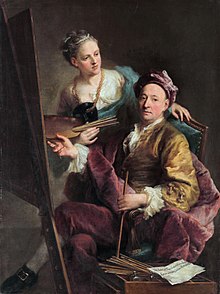George Desmarées


George Desmarées (born October 29, 1697 in Gimo , Sweden ; † October 3, 1776 in Munich ; actually de Marées ) was a Swedish painter and one of the most important portraitists of the Rococo .
Spelling of the first name
The spelling Georges is often found in older literature . In addition to George , the form Georg can be found in more modern publications, albeit very rarely . On a medal by Franz Andreas Schega from the year 1750 that was dedicated to the artist, the Latin spelling Georgius can also be found .
- 1750 portrait medal in silver and pewter, 45 mm. Front: GEORGIUS DE MAREES HOLM: SVECVS EL: COL: CONS: & PICTOR --- Half-length portrait with plait wig to the right, decorated robe and cloak, below: SCHEGA // Back: 11 lines of text. Literature: Paul Grotemeyer, Franz Andreas Schega No. 89. Hauser 326. Beierlein III, 20.
Life
After the death of his parents, Desmarées came to Stockholm, where he attended the painting school of Peter Martin van Mytens (the elder). From 1720 he was a freelance portrait painter and from the spring of 1724 went on a study trip. So he first traveled to Amsterdam and then went to Nuremberg , where he attended the drawing academy. In 1725 he came to Venice and became a student of Giovanni Battista Piazzetta .
In 1730 he was appointed to the Munich court by Karl Albrecht , the elector of Bavaria and later Emperor Karl VII., And received the title of electoral court painter. From 1743 he was appointed to numerous German princely courts. He received the most important and extensive commissions from the Cologne elector Clemens August I of Bavaria . Through this client, Desmarées also reached customers such as Archbishops Friedrich Karl von Schönborn-Buchheim and Johann Philipp Anton von und zu Frankenstein . But the Prince-Bishop of Mainz Johann Friedrich Karl von Ostein and his successor Emmerich Joseph von Breidbach zu Bürresheim also ordered pictures from Desmarées.
He was u. a. Teacher of Johann Joseph Scheubel III. (1733-1801) in Bamberg.
From 1745 to 1749 and from 1752 to 1754 he stayed at the Bonn court. In 1756 he went back to Munich, where he died shortly before his 79th birthday on October 3, 1776.
Works
Desmarées created a very large number of portraits; There are more than 50 of the Bavarian princely family alone. He also painted pictures with spiritual and profane subjects, many of which were also engraved.
In Augustusburg Castle in Brühl there are over a dozen paintings by his hand; just as many were found in Clemensruhe Castle in Poppelsdorf. Further works are u. a. in Munich (Residenz, Lenbachhaus, Amalienburg, Theatinerkirche, Alte Pinakothek ...), Madrid (Museo Thyssen-Bornemisza), Fulda (Adolphseck Castle), Neue Residenz (Bamberg) , Würzburg (Residenz / Fürstensaal, Mainfränkisches Museum), Polling (church) , Ettal Abbey.
literature
- Wilfried Hansmann, Gisbert Knopp : Fine arts at the time of the Electors Joseph Clemens and Clemens August . In: "International Artists in Bonn 1700-1860", Ludwig Röhrscheid Verlag, Bonn 1984
- Carl Hernmarck: Georg Desmarées , Uppsala 1933
- Laurentius Koch: Marées, Georges des. In: New German Biography (NDB). Volume 16, Duncker & Humblot, Berlin 1990, ISBN 3-428-00197-4 , pp. 143-145 ( digitized version ).
- Laurentius Koch: New discoveries about his work. In: Weltkunst No. 19, 1992
- Josef Niesen : Bonn Personal Lexicon. Bouvier, Bonn 2007, ISBN 978-3-416-03159-2 .
- Richard Paulus : The portrait painter George de Marées (= Bavarian Art 1/2). Hertz, Munich 1913.
- The lady with the rose. In: Weltbild No. 23/24, 1997
Web links
| personal data | |
|---|---|
| SURNAME | Desmarées, George |
| ALTERNATIVE NAMES | Marées, George de |
| BRIEF DESCRIPTION | Swedish painter |
| DATE OF BIRTH | October 29, 1697 |
| PLACE OF BIRTH | on Gimo , Sweden |
| DATE OF DEATH | October 3, 1776 |
| Place of death | Munich |
